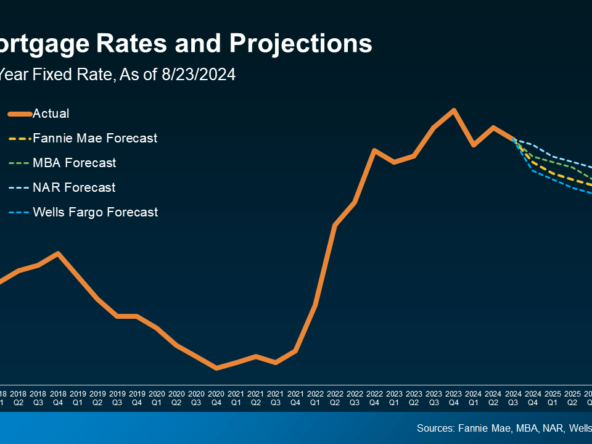Mortgage rate buy downs can be a win-win situation for both buyers and sellers in today’s market. A buydown is when a lender or third party provides funds to lower the interest rate on a loan. A seller-paid rate buydown can typically help buyers save more money on monthly mortgage payments than if they negotiated a lower purchase price. It can also be cheaper for the seller to pay for discount points than to reduce the home price. And while rate buydowns can be a thrifty way to close the deal, they do come with their risks. Here’s what you need to know about seller-paid rate buydowns, so you can decide if this strategy can help you buy or sell a home this year.
How Seller-Paid Mortgage-Rate Buydowns Work
A seller-paid rate buydown is when the seller offers concessions that reduce the buyer’s mortgage interest rate, either for the duration of the loan or just for the first few years. This can happen in one of two ways: The seller contributes to the buyer’s closing costs, or the seller pays for a temporary rate buydown.
Option 1: The Seller Offers Money Toward Closing Costs
With a permanent rate buydown, the seller pays a portion of the buyer’s closing costs that are used toward buying mortgage discount points. Each point reduces the rate by about 0.25 percentage point, depending on the lender, and costs 1% of the loan amount. So if you buy a $500,000 home with a 20% down payment, your mortgage amount would be $400,000, and each point would cost $4,000.
Of course, many homeowners won’t adhere to the entire payment schedule of a 30-year fixed-rate mortgage. Some of them will sell or refinance their home well before then, while others will make extra principal payments to get out of debt faster. So when it comes to rate buydowns, consider your long-term plan and find the break-even point – that is, how long it would take you to save enough money to outweigh the money spent on buying points.
Option 2: The Seller Pays for a Temporary Rate Buydown
Another option that’s gaining popularity is the temporary rate buydown, which lowers the buyer’s mortgage rate for the first few years of the loan. The cost of a temporary buydown is equal to the amount that the buyer would save over the reduced-interest period, which essentially makes it a way for the seller to prepay interest on the buyer’s behalf.
Temporary rate buydowns may be a better option for buyers who plan on selling or refinancing their homewithin a few years, while permanent buydowns can be a good choice for those who are buying their forever home. It also depends on how much money the seller is willing to contribute in buying down the mortgage rate. And before agreeing to this type of buydown, be sure that you can afford the final monthly payments once the buydown period expires.
The Benefit of Seller-Paid Rate Buydowns
Often, a mortgage-rate buydown is mutually beneficial for the buyer and the seller. It can be cheaper for the seller to help pay for discount points rather than to budge on the purchase price – and it can also save the buyer more money on monthly mortgage payments and over the life of the loan. See an example of how a rate buydown compares with a price reduction in the table below:
| Price Reduction of $25K | Seller-Paid Discount Points | 2-1 Rate Buydown | |
| Purchase Price | $475,000 | $500,000 | $500,000 |
| Down Payment Amount (20%) | $95,000 | $100,000 | $100,000 |
| Loan Amount | $380,000 | $400,000 | $400,000 |
| Mortgage Rate | 6.5% | 5.75% | 4.5% in first year, 5.5% in second year, 6.5% in third year and beyond |
| Cost to Seller | $25,000 | $12,000 | $9,104 |
| Monthly Principal & Interest Payment | $2,402 | $2,334 | $2,027 in first year, $2,271 in second year, $2,528 in third year and beyond |
| Lifetime Interest Paid by Buyer | $484,669 | $440,345 | $501,074 |
In the example above, the homebuyers would be able to save an additional $67 on their monthly payment and pay nearly $45,000 less in interest over the life of the loan if the sellers paid for discount points than if they reduced the purchase price. And the sellers would save $13,000 by buying down the rate instead of dropping the price.
In the case of a temporary rate buydown, the buyers can benefit by saving on interest in the short term but will pay more interest over the course of a 30-year mortgage. The monthly payments will be lower for the first two years of the loan, while rising to the nondiscounted rate for the remainder of the term.
The Risk of Seller-Paid Rate Buydowns
Despite the financial benefits, rate buydowns may not be the best way to get seller concessions. The money a seller would pay toward discount points may be better used toward other closing costs or home repairs instead.
If rates are on a downward trend, it may pay off to negotiate a lower purchase price and refinance to a reduced rate down the line. That way, you have a smaller loan amount and the opportunity to lock in a lower rate when market conditions are in your favor.
You may also decide to wait until rates do fall to buy a home, although that can also be a gamble. It’s not advisable to try to time the housing market, since no one knows for certain where rates and home prices are headed.
Alternative Seller Concessions to Consider
Rate buydowns can be a good tool to bridge the affordability gap when mortgage rates are high, but they’re not your only bargaining chip. Besides asking for a seller-paid rate buydown, there are several other types of seller concessions that are worth exploring:
- Lower purchase price. While negotiating the purchase price may not save you much money on your monthly payments, it will reduce your loan amount – and, by extension, your down payment.
- Money toward other closing costs. The seller may agree to cover part or all of the closing costs, such as prepaid interest, property taxes, loan origination fees and title insurance, for example. Remember that there are limits to how much a seller can contribute toward closing costs.
- Cash for home repairs. If you’re buying a home that needs a bit of TLC, the seller may be willing to contribute money toward repairs at closing.
- Purchase contingencies. While many buyers waive contingencies to get their offer accepted in a hot market, it’s possible to include home inspection, financing and appraisal contingencies when there’s less competition. That way, if the deal fails through no fault of your own, you don’t risk losing your earnest money.
When making a decision about rate buydowns, think about what you want out of a home (and your mortgage). If getting a low rate is a top priority, then a seller-paid buydown can help you achieve that. But if you plan on refinancing to a lower rate, then mortgage discount points may not be worthwhile – although a temporary rate buydown can still help you save money in the near term. Be sure to discuss your options with me when putting together a competitive offer.






